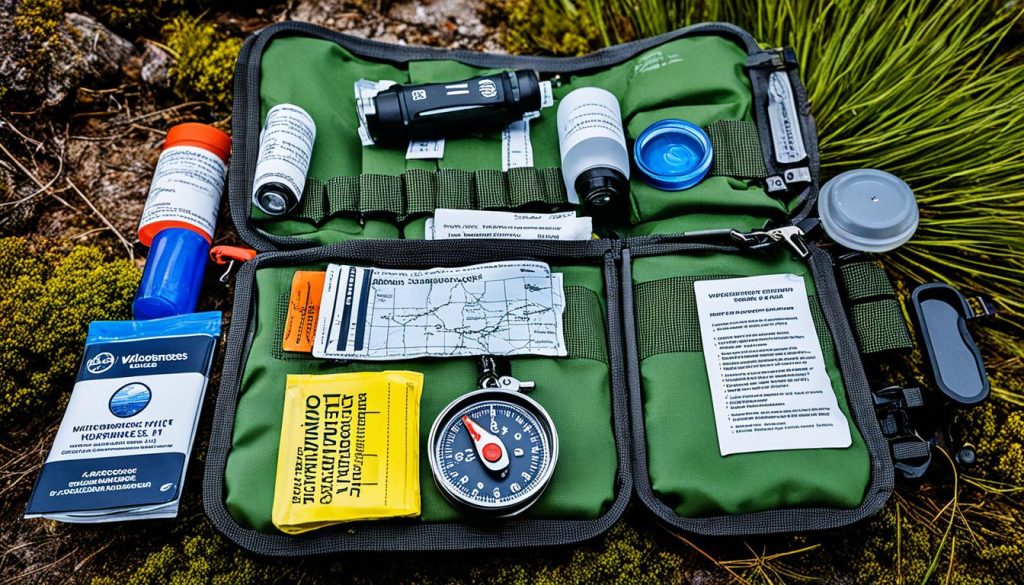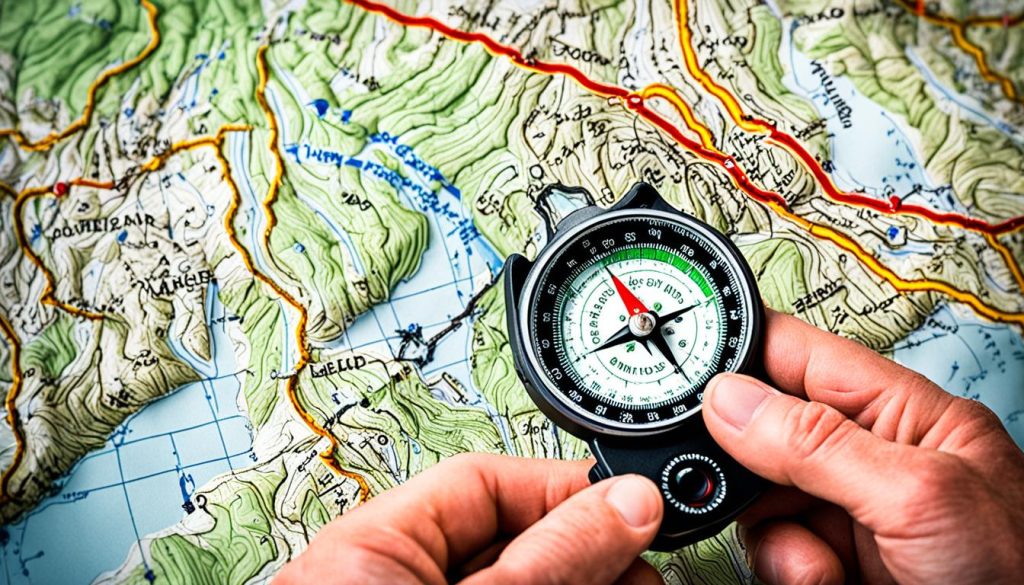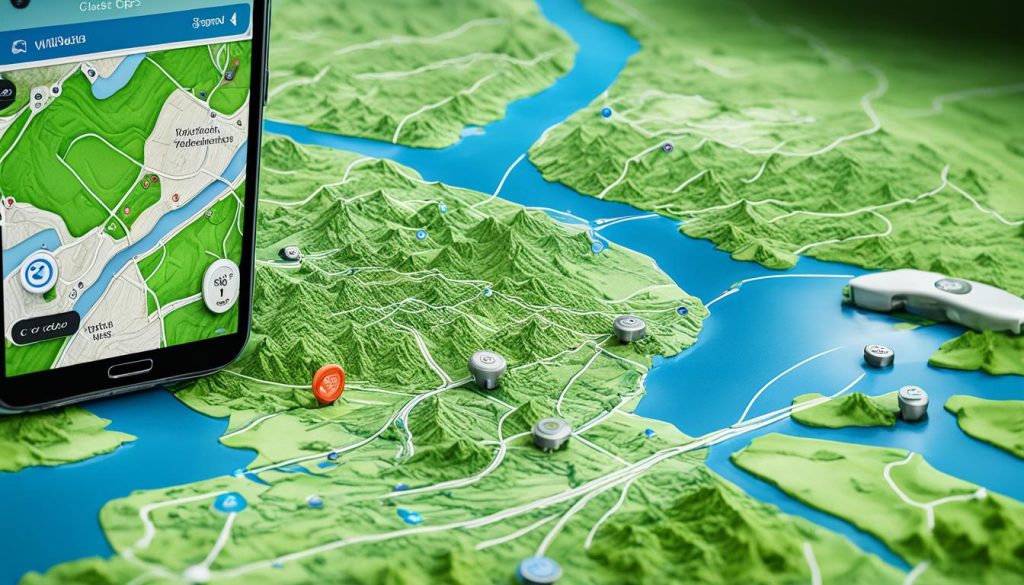Did you know that an estimated 97% of backcountry travelers get lost at some point during their outdoor adventures?
Wilderness navigation is a crucial skill for anyone venturing into the great outdoors. Whether you’re hiking, camping, or exploring the wilderness, knowing how to navigate using maps, compasses, and GPS devices can mean the difference between a safe and successful trip or getting lost in the vastness of nature.
In this article, I will provide you with expert tips and insights to master wilderness navigation. From map and compass techniques to orienteering basics and essential backcountry survival skills, you’ll learn everything you need to confidently navigate the wilderness and ensure your safety.
Key Takeaways:
- Wilderness navigation is essential for outdoor enthusiasts to ensure their safety.
- Mastering map and compass skills is crucial for accurate navigation.
- Having a backup plan and communication strategy is vital for emergencies.
- GPS devices and modern navigation tools can enhance your wilderness exploration.
- With expert tips and insights, you can confidently navigate the wilderness and enjoy off-grid adventures.
The Importance of Navigation Basics in the Wilderness
Before embarking on any wilderness adventure, it is essential to master the basics of navigation. Understanding map and compass techniques, as well as orienteering basics, will empower you to explore the wilderness with confidence. These skills are crucial for staying on track and ensuring your safety in unfamiliar terrain.
A compass is a vital tool for wilderness navigation. It provides a reliable method for determining your direction and finding your way back home if you become disoriented. By learning how to hold a compass properly and interpret its markings, you can navigate effectively and make informed decisions about which path to take.
Map reading is another fundamental skill for wilderness exploration. Maps provide valuable information about the surrounding terrain, including landmarks, trails, and topography. By studying maps and familiarizing yourself with the symbols and colors used, you can plan your route and navigate by referencing key features along the way.
Becoming proficient in orienteering techniques is equally important. Orienteering involves using a map and compass together to navigate accurately and efficiently. By aligning your compass with the map and employing various techniques such as triangulation and handrailing, you can navigate through challenging terrain, even without well-defined trails.
By honing your map and compass skills and understanding orienteering basics, you can confidently explore the wilderness and minimize the risk of getting lost. These navigation techniques will provide you with a sense of direction and enable you to navigate off-grid, opening up a world of adventure and discovery.
Common Mistakes to Avoid in Wilderness Navigation:
- Relying solely on GPS devices without backup navigational tools or knowledge
- Failure to account for declination when using a compass
- Inadequate map preparation and route planning
- Not staying oriented to known landmarks or features
- Overlooking environmental factors that may affect navigation, such as weather or changes in terrain
By avoiding these common mistakes and investing time in mastering map and compass techniques, orienteering basics, and wilderness navigation skills, you will embark on your outdoor adventures with confidence and preparedness.
Creating a Backup Plan and Communication Strategy
When venturing into the wilderness, it’s vital to have a backup plan and a communication strategy in case of emergencies. Being prepared can make all the difference in ensuring your safety and the safety of your companions. Here are some key steps to take:
1. Create an Itinerary
Before heading out, create a detailed itinerary that includes specific points of interest, trails, and campsites you plan to visit. Share this itinerary with a trusted friend or family member who can contact authorities if you fail to return on time. This helps ensure that someone knows where you are and can initiate a search and rescue if necessary.
2. Carry Essential Gear
Carrying the right gear is crucial for any outdoor adventure. In addition to the essentials like food, water, and appropriate clothing, make sure you have an emergency kit and a first aid kit. The emergency kit should include items such as a flashlight, a whistle, a multi-tool, extra batteries, a waterproof fire starter, and a signaling mirror. These items can assist you in various emergency situations.
3. Establish a Communication Plan
Establishing a communication plan with your family and friends is essential. Before you embark on your wilderness adventure, discuss how often and through which means you’ll communicate your status. This can be through satellite communicators, two-way radios, or even simple text messages if you have cell reception. Stick to the plan and update your loved ones regularly, especially when you reach significant landmarks or complete portions of your itinerary.
4. Know Evacuation Routes and Emergency Shelters
Do your research before heading into the wilderness. Familiarize yourself with evacuation routes and emergency shelters in the area. Knowing where the closest shelter or evacuation point is can save precious time in a crisis. Take note of any specific instructions or procedures provided by park rangers or guides.
5. Stay Informed and Adapt
Weather conditions, trail closures, and other unforeseen circumstances can impact your trip. Stay informed by regularly checking weather forecasts and trail conditions. Be prepared to adapt your plans accordingly to ensure your safety.

By creating a backup plan and communication strategy, you are taking proactive steps to enhance your safety and the safety of those around you while exploring the wilderness. Remember, preparation is key, and being equipped with the right knowledge and resources can make your outdoor adventure more enjoyable and worry-free.
Mastering Map and Compass Skills
Maps and compasses are essential tools for wilderness navigation, providing crucial information and helping adventurers stay on the right track. Understanding how to use them correctly is vital for successful navigation and safe travels in the wilderness.
Using a Compass
The compass is a reliable companion when navigating through unfamiliar terrain. To make the most of this tool, it’s important to learn how to use it effectively:
- Orientate the compass with respect to the map to determine true north.
- Familiarize yourself with different types of compasses and choose one that suits your navigation needs.
- Hold the compass level and steady, ensuring it’s not affected by any electromagnetic interference.
- Read the compass’s markings accurately to determine your direction and maintain your course.
Using a Map
Maps provide valuable information about the surrounding terrain, including landmarks, elevation, and water sources. Here’s how to make the most of maps for navigating in the wilderness:
- Learn to read maps and interpret symbols and colors. This knowledge will help you understand the terrain and plan your route effectively.
- Identify key landmarks and features on the map and use them as reference points during your journey.
- Consider the scale of the map to accurately gauge distances and estimate travel time.
- Be aware of contour lines on the map, which depict changes in elevation. This information will help you navigate slopes and avoid steep terrain.
By mastering map and compass skills, you’ll be equipped with the knowledge and tools necessary to navigate confidently and accurately in the wilderness.

Types of Compasses
| Compass Type | Features |
|---|---|
| Baseplate Compass |
|
| Mirror Compass |
|
| Lensatic Compass |
|
Choosing the right compass for your needs can greatly enhance your wilderness navigation experience.
GPS Devices and Modern Navigation Tools
GPS devices and modern navigation tools have transformed the way we navigate in the wilderness. These advanced technologies provide us with highly accurate and reliable information, enabling us to explore remote areas with confidence. By understanding the differences between GPS units and traditional compasses, we can harness the power of both systems to enhance our wilderness navigation skills.
GPS units, or Global Positioning System devices, utilize satellite signals to determine our precise location. With just a few clicks, we can obtain our coordinates, track our movement, and follow pre-set routes. The convenience and precision offered by GPS devices make them indispensable companions for outdoor enthusiasts and adventurers.
However, relying solely on GPS units can be risky. It’s essential to have backup power sources, as these devices rely on batteries that can drain unexpectedly. Additionally, satellite signals can be obstructed by dense tree cover or tall mountains, limiting their effectiveness. Therefore, it’s crucial to always carry traditional navigation tools, such as maps and compasses, as a backup.

By combining the strengths of GPS units and traditional navigation tools, we can navigate the wilderness with confidence and accuracy. Before setting out on our adventure, we can use maps to study the terrain, identify potential landmarks, and plan our routes. Once in the field, GPS units can aid us in tracking our progress, while compasses can help us maintain our sense of direction.
Furthermore, embracing modern navigation tools allows us to access additional features beyond basic navigation. Many GPS units offer altitude tracking, weather updates, and location sharing functionality, enhancing our overall wilderness experience. Before venturing into the wilderness, ensure you familiarize yourself with your chosen GPS unit’s features and functionalities.
Remember, no navigation system is foolproof, and technology can sometimes fail us. Developing a solid foundation in traditional navigation skills provides us with a reliable backup plan, ensuring we can navigate in the wilderness even during challenging circumstances. By blending the power of GPS devices and modern navigation tools with traditional navigation techniques, we can explore the wilderness safely and efficiently.
Conclusion
Mastering wilderness navigation is essential for any outdoor enthusiast. By understanding the basics of map and compass use, orienteering, and modern navigation tools, you can confidently explore the wilderness and navigate off-grid.
Remember to always have a backup plan, communicate effectively, and carry the right equipment. Creating an itinerary, sharing it with someone you trust, and carrying essential gear like emergency and first aid kits are crucial steps to ensure your safety.
With these trailblazing tips and insights, you’ll be well-prepared for successful and safe off-grid adventures. Whether you’re hiking, camping, or exploring the great outdoors, mastering wilderness navigation will empower you to navigate through uncharted territory and discover hidden gems with confidence. Happy trailblazing!
